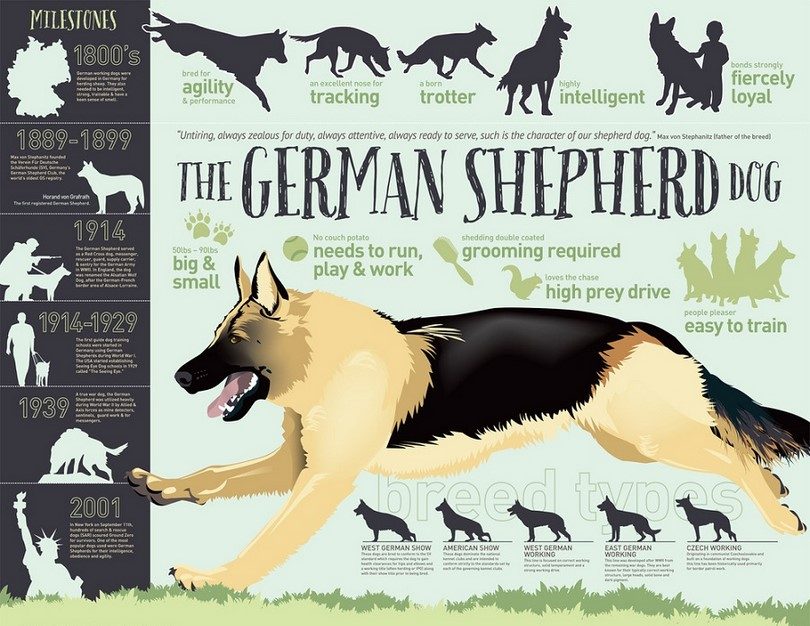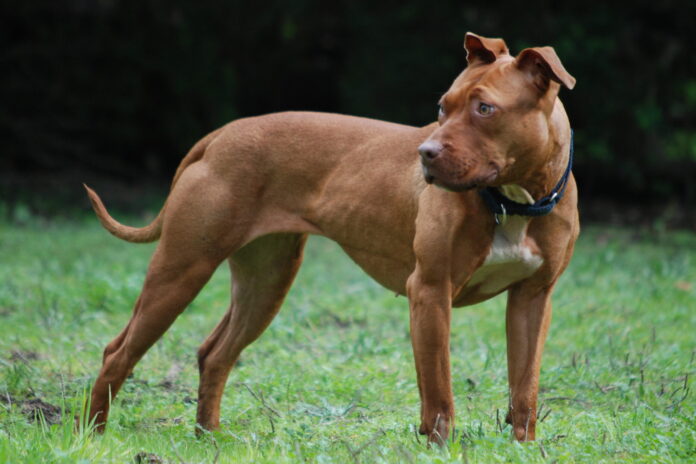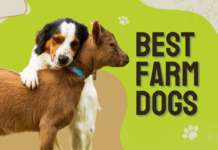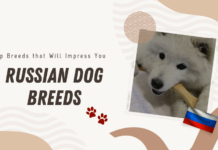One of the main concerns you may have when it comes to interacting with a man’s best friend is the level of risk that might be involved with a particular breed. You may have received conflicting information, or you may not trust the validity of media reports because so many owners have told you about a wide range of experiences.
Well, the truth is that dogs of all types can and will show hostility to strangers, small children, familiar people, and even their owners. This unacceptable behavior stems from a number of factors including poor breeding, training, and treatment, but one of the most influential factors in behavior is its original purpose.
This article contains information about the most aggressive dog breeds. You will find some familiar names on this list, such as the American Pit Bull and Rottweiler, and you may find a few that surprise you, like the Beagle and Dachshund. Remember, there is a difference between being dangerous and displaying aggression.
Large dogs often get a bad rap because when they attack or otherwise act out they tend to do more damage than the smaller ones. Many small ones, especially terriers, were bred to hunt, and in many instances kill, animals larger than themselves. It appears that no matter how far removed from its ancestors, most retain the instinct and urge to do the work for which they were originally intended.
1. Chow Chow

One of the oldest known breeds, the Chow Chow is also considered to be one of the most aggressive. They stand approximately 17 to 20 inches tall and weigh 45 to 70 pounds. Their large size and thick coat made them perfectly suited as guard dogs. Some historians claim that they were originally bred to defend temples in China, Mongolia, and Tibet.
They were also used for hunting, herding, and pulling carts. There are accounts of Chows fighting alongside the Mongolians as they invaded China and Eastern Europe during the Middle Ages. With such a background, it is only natural that the breed still has an aggressive nature.
While not a typically active breed, Chows tend to focus their energy on giving affection to and protecting their owners. They are often referred to as “one-person” dogs who favor one member over others within a multi-person family, and are known to show little tolerance for the rest of the family. They may even perceive play between their owner and another person as a threatening to their owner and attack.
They have little tolerance for those of the same sex, and have been known to attack small dogs, cats and even children. When strangers come near, Chows will go on the defensive, bite with little warning, and sometimes have pressed the fight until the point of death.
Even experienced trainers have reported difficulties when training Chows. Their instinct to dominate clashes against even the most skilled trainers, whose attempts to correct has sometimes resulted in the animal lashing out. While Chows can be trained to become loving and loyal members of the family, they must be handled carefully and with plenty of patience. Learn more about the basic characteristic of the Chows in our article on the breed.
2. German Shepherd
Relative newcomers to the long tradition of breeding herding dogs, German Shepherds first appeared in the early 1900s to herd sheep and since then have taken a variety of roles all around the world. They have served in the military, on police forces, and as key members of search-and-rescue operation teams.
They are also highly regarded as service and therapy dogs, guardians of the home, and a few have even stared on the silver screen. They have been able to fill these important roles in society due to their loyalty and trainability, but at the same time, they also possess a fierceness that must be reckoned with.

Male German Shepherds stand approximately 25 inches tall and weigh around 80 pounds; females are slightly smaller. They are sleek, quick, and have an intimidating appearance. This appearance negatively influences their reputation as an animal that likes to show its dominance, which they will if they are allowed to. This attitude makes it difficult to trust them when other pets or children are around.
They do form strong bonds with their owners, and sometimes the bond is so deep that the dog will develop the inability to tell the difference between threatening and non-threating people or situations. They are known to give plenty of warning, but if the threat is not immediately removed, they will strike.
3. American Pit Bull Terrier
Perhaps the most notorious of all breeds, the American Pit Bull Terrier was bred to bait much larger animals, such as bears and bulls. Butchers would use them to control bulls in the slaughterhouse yards, but once this practice was ruled inhumane, inhumane humans began to use them to fight to the death in illegal matches.
While they have been used for more practical purposes, such as herders and feral pack hunters, they were more often than not bred as for illegal fighting in underground “pits.”

They are often used as attack dogs, there have even been man accounts of drug dealers training them to be used as a weapon against police during drug raids.
Pit Bulls stand between 18 to 24 inches tall and weigh between 30 to 60 pounds. They are compact animals, with a muscular physique and a very active temperament. If they don’t get enough exercise, they will attempt to burn off their energy by destroying furniture and just about anything else they can get their paws on. They are loyal, great companions, and strive to take part in all family activities; however, no matter how stable they may seem to be within a home, their history of being a fighter will always be lurking beneath. Check out our piece on how to train and raise a Pit Bull to help you manage this dauntless dog.
They typically do not get along with strangers or with strange dogs, and will often see either one as a challenge. They will also rebel against abuse, even if it is the unintentional sort delivered by children. Pit Bulls were bred to be fighters, and because of this, they will not back down from a fight. It’s this fact alone that has given them the reputation of being so vicious. This ill fame has led them to be banned in many areas across the United States and even entire countries.
4. Rottweiler
The Rottweiler has an extensive history as a herding dog, especially large livestock, such as cattle and were also used protect pens and stables from thieves and predators. They were used extensively for protection for merchants throughout the Middle Ages, and were even known to pull carts to market.
In later years, they were repurposed as police and military service dogs, and ultimately as guardians and family companions. But as much distance that has been put between history and the present, Rotties will always have the instinct to protect the territory of their masters. Our piece on the Rottweiler will help you decide if this is the dog for you.

Rottweilers can grow to 27 inches and weigh up to 115 pounds. They are a strong, powerful breed that is well suited to taking on the challenges they were always meant for. They display an air of confidence, and they are patient, usually waiting to see how a particular situation develops before taking action. They are loyal to their owners and seek to please them through guarding perceived territory and warding off intruders.
Rotties have dominance issues that even experienced trainers have difficulty controlling, and they have been known to rebel in response to anger. While there are often reports of them turning on their owners or going after other dogs, they focus most of their aggression toward strangers. If they perceive someone as a threat to owner, territory, or their own dominance, they will not hesitate to attack.
5. Doberman Pinscher
Originally bred by Karl Friedrich Louis Dobermann in the late 1800s to protect him while collecting taxes in dangerous neighborhoods, Dobies come from a line of mixed-breed shepherds and a number of others. Herr Dobermann’s idea was to create an intelligent, agile, and alert comapnion that would intimidate people out of robbing him, and his efforts became such a success that by the end of the century, Doberman Pinschers were filling roles as guard and police dogs all around the world.
They were even named as the United States Marine Corps official war dog during World War II. Their reputation for being ferocious is certainly warranted, because that is what they were designed to be.

Doberman Pinschers reach up to 28 and weigh between 70 and 75 pounds. Their size makes them perfect for the role for which they were bred, and they have been known to use this size to their advantage by charging fearlessly at threats they sense, often bowling over their targets, or pinning them against objects. If their target fights back, then the potential for it to attack violently greatly increases.
They are loyal to their owners, and make for great companions in that regard, but are known to have trouble discerning the level of a threat from strangers unless they undergo strict training. They are also more likely than most other breeds to attack other dogs. Know more of this dog when you read our article on the Doberman.
6. Beagle
Then modern strain of Beagle dates back to the early 1800s, but centuries before then, its ancestors had been prized scent hounds. The modern ones were primarily trained to run in packs to flush out and track down small game, and are still used for that purpose, although singularly or in pairs.
In some parts of the world, they act as service dogs to sniff out drugs and food items hidden in luggage. Due to their ingrained desire to hunt, they have a tendency to be easily excitable, which can lead to a display of aggression.

Beagles are small to medium sized, standing approximately 15 inches and weighing between 18 and 35 pounds. They don’t appear to be hostile, and it may be hard not to think of Snoopy when you hear the name, but Beagles are rated one of the more aggressive breeds. One of the reasons could be that they are difficult to train. They tend to focus on scents, so any number of smells in the area can distract them.
Untrained or poorly trained dogs are usually more possessive than others, and will lash out at anyone who attempts to take something away from them, including game. Many owners have claimed to have possession issues with their Beagles, which is its way of displaying dominance. If this behavior is not corrected swiftly, it will begin to become an even bigger problem. Check out our article on the Beagle to help you understand this breed better.
7. Dachshund
Although there is much debate on the origins of the “sausage dog,” there is strong evidence to suggest that the Dachshund was bred to crawl into badger holes to root out badgers. They were also used to hunt all sorts of game, including fox, boar, and wolverine. To do this, they needed traits such as fearlessness and tenacity, and it appears that they got them in spades.
They can crawl into an animal’s burrow and will not leave until they have pulled it out by their sharp little teeth. Doxies are no longer used for hunting, but on the whole, they still retain much of the aggressiveness required to take on the likes of a badger.
Weiner dogs average about 8 inches tall and weigh about 14 pounds. Their size often gives them a pass for their behavior, but according to recent studies, they show more aggression than any other dog, regardless of size. They are extremely territorial, which not only translates to their homes, but their possessions as well.
They will not hesitate to bite small children if they believe that the child is attempting to take their toys. They are also extremely stubborn, and therefore, difficult to train and even more difficult to control once they have set their mind on something. All in all, Doxies have the ultimate “small dog complex;” they want to dominate as if they are trying to prove a point.

Dachshunds are apt to display aggression toward strangers and other dogs at higher rate than most canines, but they outrank all others when it comes to turning on their owners. There have been numerous accounts of them biting or snapping at their owners, especially when not getting their way. One owner even reported that she had to put down her Doxie because it gnawed off her toe when she was asleep.
8. Chihuahua
There is not much in the way of history behind the Chihuahua to indicate why it is considered one of the most aggressive types of dogs. In fact, it seems that the only real purpose they served was to be raised as food for the Aztecs (though that is debatable). They weigh only 4 pounds, but don’t like to be pushed around.
They can be stubborn and difficult to train, but they are staunchly loyal to their owners and accepting to the presence of other Chihuahuas. As far as strangers are concerned, these tiny powerhouses are quick to bare their teeth, growl, and bark incessantly. They are known to bite strangers, small children, and other dogs that they believe are encroaching on their territory.

Much of the source of aggression may be explained by the fact that people tend to discipline Chihuahuas somewhat differently than they would a larger pet. Owners often allow their dogs to act out aggressively because the behavior is considered “adorable” in such a tiny thing. If it is allowed to act this way, it becomes learned behavior, therefore, it is apt to act out with aggression more often.
9. Jack Russell Terrier
The Jack Russell Terrier traces its roots back over 200 years to a time when dogs of all sizes were bred for specific tasks. This breed size was perfect for hunting small game, especially foxes, and their ability to dig, bark, and act aggressively toward the quarry played a huge role in their popularity.
After World War II, fewer people hunted so Jack Russells became family companions instead. While they are now primarily in homes, they retain the high energy level and assertiveness they’ve always had.

Jack Russell Terriers stand a mere 14 inches tall and rarely weigh more than 18 pounds, but their personalities are twice as big. They can be great family companions, even to small children, and will play for as long as they are allowed.
They are easily trained to do tricks and tasks that require a lot of energy, but this is only because it is in their nature to extremely active at all times. They are hunters, and if left alone with nothing to do, they will attempt to hunt. Jack Russells are famous barkers, and often show their teeth to and even bite strangers.
Jack Russells have the distinction of despising the company of other breeds. They view other dogs as invaders into their territory, so when confronted with one they will often go immediately on the attack. They particularly act hostile toward those animals who they know to be aggressive, irrespective of size. Also, they rarely tolerate dogs of the same sex, so it is never wise to leave two males or two females unsupervised.
10. Yorkshire Terrier
Another diminutive member of the terrier group, the Yorkshire Terrier was developed in the mid-1800s to hunt vermin in clothing mills and mines. They were also brought along on hunts to root out the small and medium-sized games from their dens. Yorkies had to be extremely bold to take on such a task, as well as defend themselves against the claws and teeth of badgers and the like.
In the mid to late 1900s, their ability to grow long, silky hair attracted the attention of the upper classes, and soon became a popular lapdogs. Unfortunately, no matter how innocent the brushed hair and bows make them appear they are not as far removed from breaking the necks of rats and battling foxes as many of their owners would like to believe.

Standing approximately 7 inches tall and weighing little more than 7 pounds, full-grown Yorkies may not appear much of a threat to anyone, but they do have an aggressive streak. As terriers, they remain hunters, who will attempt to seek out prey if given the opportunity, and depending on the dog, the size of the target may not matter. They also have a reputation for not getting along with members of their own breed, especially when confronted with those of the same sex.
Owners with multiple Yorkies have reported that their pets developed a pack mentality, one in which the weakest would be singled out for attack and denial of food. They are a territorial lot who will challenge strangers and small children alike with barking and nipping, and sometimes even biting. Owners who do not assert themselves as masters will have a particular challenge attempting to control a Yorkie’s temperament because he will believe that he is the boss.
Don’t Hurry to Judge
Any dog faced with a confusing or threatening situation has the potential to become violently aggressive, but some breeds are more predisposed to carrying out that threat. Training and treatment are key factors in an animal’s temperament, but it is always a good idea to know the history behind a type of dog and what it was bred for before choosing one as a family pet. Another point to consider is the environment in which it will live.
Finally, anyone who interacts with dogs must also remember that they shouldn’t base their judgments about the dangerous animal may pose on its size. Small ones are just as liable to turn on their owners as the large ones, and in cases like the Dachshund, are even more apt to do so.




